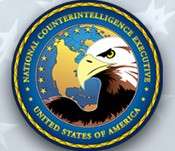National Counterintelligence and Security Center
The National Counterintelligence and Security Center (NCSC) leads national counterintelligence (CI) for the United States government. It is part of the Office of the Director of National Intelligence (ODNI).
 Seal of the National Counterintelligence and Security Center | |
| Agency overview | |
|---|---|
| Formed | January 5, 2001 |
| Preceding agencies |
|
| Jurisdiction | Counterintelligence on behalf of the federal government of the United States |
| Agency executive |
|
| Parent department | Director of National Intelligence |
History

The Office of the National Counterintelligence Executive (ONCIX) was established on January 5, 2001 by a directive from President Bill Clinton which also established the National Counterintelligence Board. It replaced the National Counterintelligence Center, which was created in 1994 in response to the arrest of CIA mole Aldrich Ames.[1]
In November 2014, the Director of National Intelligence established NCSC by combining ONCIX with the Center for Security Evaluation, the Special Security Center and the National Insider Threat Task Force, to effectively integrate and align counterintelligence and security mission areas under a single organizational construct.[2] With this reorganization, the ONCIX ceased to exist as a separate organization.
Role
The ONCIX facilitates and enhances US counterintelligence efforts and awareness by enabling the CI community to better identify, assess, prioritize and counter intelligence threats from foreign powers, terrorist groups, and other non-state entities; ensures that the CI community acts efficiently and effectively; and provides for the integration of all US counterintelligence activities. Its official mission[3] is to:
- Exploit and defeat adversarial intelligence activities directed against US interests.
- Protect the integrity of the US intelligence system.
- Provide incisive, actionable intelligence to decision-makers at all levels.
- Protect vital national assets from adversarial intelligence activities.
- Neutralize and exploit adversarial intelligence activities targeting the armed forces.
The National Counterintelligence Executive chairs the National Counterintelligence Policy Board, the principal interagency mechanism for developing national CI policies and procedures, and directs the National Counterintelligence and Security Center.
While ONCIX does not distribute warnings of potential threats to the private sector, it works closely with the FBI's Awareness of National Security Issues and Response (ANSIR) program, the State Department's Overseas Security Advisory Council (OSAC) as well as the Central Intelligence Agency (CIA) to ensure that such warnings are timely made.[4] The Office of Counterintelligence of the National Geospatial-Intelligence Agency maintains a full-time presence within ONCIX.[5]
Leadership
On August 7, 2006, Director of National Intelligence John D. Negroponte appointed Joel F. Brenner to serve as National Counterintelligence Executive and Mission Manager for Counterintelligence.
On September 21, 2009, Robert "Bear" Bryant was appointed as the National Counterintelligence Executive.[6]
In May 2014, DNI James R. Clapper appointed William Evanina, a former FBI special agent with a counterterrorism specialty, as the new National Counterintelligence Executive.[7]
Notes and references
- Singh, Samir (January 19, 2001). "Clinton Establishes New Federal Counterintelligence Organizations". American Association for the Advancement of Science. Retrieved 2007-09-08.
- "History of NCSC". U.S. Office of the Director of National Intelligence. Retrieved 2019-09-27.

- Office of the National Counterintelligence Executive
- Roper, Carl A. (2013). Trade Secret Theft, Industrial Espionage, and the China Threat. Boca Raton, Florida: CRC Press. p. 164. ISBN 978-1-4398-9938-0.
- Roper 2013, p. 171
- Office of the Director of National Intelligence
- Clark, Charles S. (15 August 2014). "Meet the Man Who's Gauging the Damage From Snowden". Government Executive (National Journal Group, Inc.). Archived from the original on 12 May 2016.
